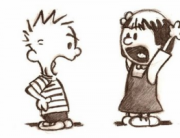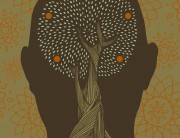Non-linear people in a linear world
I used to teach a class called “Understanding Anger and Anxiety”. The class was quite lengthy, taking an entire day. While the class could be summed up in one simple sentence, “Anger is anxiety”, I invested several more hours so that that point would be fully understood and appreciated. I warned the class at the beginning that when I am trying to teach something important, I speak in concentric circles, working my way around the perimeter of the concept, introducing several threads that may at first appear to be unrelated, and then gradually narrowing in on the main point. In this way, they have the proper context for the final, parsimonious concept that I want them to walk away with.
Despite this warning, it was obvious to me as the class proceeded that there were people who were having a hard time hanging in there with me as I wandered through philosophy, psychology, sociology, and neurophysiology. As we went around and around in circles talking about so many seemingly unrelated points, their eyes would glaze over. After the class, I sent out e-mails asking for feedback and there were a few people who gave me feedback that they would have preferred that I get to the point sooner. However, the majority of the people expressed that nobody had ever explained the concept in such a way before, and that due to the way that I proceeded, it made perfect sense to them.
What is the difference between these two groups of people? I believe it comes down to one thing, the ability to walk in a straight line. What I’m referring to is the separation of people into two groups, linear people and nonlinear people. Linear people prefer to move through life in a stepwise progression. They begin step 1 with step 10 in mind but only proceed to step 2 when step 1 is completed and then proceed to step 3 and so on. The nonlinear person has a vague idea that there is something resembling a step 10, and because of this, knows that there must be a step 1 but is unclear as to what that step may be. In addition to this lack of clarity about the beginning, the middle appears to be a total mystery.

Like, where’s step two Scoob? Zoinks (worst caption ever?)
However, beyond the lack of clarity regarding the middle portion of the process, there is an underlying feeling for the non-linear person that they should know, that because they don’t know, there is something wrong or deficient with them that needs to be corrected. This underlying guilt is the product of a very successful program of belief-building known as culturization, defined very obviously by dictionary.com as “to expose or subject to the influence of culture.” We know when culturization is effective when people who resist the influence of culture either feel guilt or shame for doing so or others attempt to make them feel that way. This indicates that the values and beliefs that have been decided upon by the larger culture have worked their way into the bedrock of the individual’s core beliefs.
We know when we have reached a core belief when we can no longer explain the belief. For example, when I ask people why it is wrong to bully someone else, they will usually answer that the strong should not take advantage of the weak. I will then ask why not. The answer is usually some variation of “because they are defenceless or helpless etc.” I then ask them a question that leads to much aggravation, “Why is it wrong to take advantage of someone who is helpless and defenceless?” The answer, invariably, comes down to, “It just is.” This is how we know we have arrived at a core belief. Core beliefs just are. They have been instilled in us for such a long period of time that we cannot even determine their origin.
How do we know that such a value is merely a belief and not a universal, moral absolute? Because there are entire cultures that do not share that belief. There are cultures wherein the above-mentioned line of questioning would be to explore the acceptance of bullying, even by the bullied. “Why is it OK for the caste system to persist? Why is it OK for the strong to dominate the weak?” The answer is the same. “It just is”.
It is this same process that gives the non-linear person the frame of reference that their way of being and existing is fundamentally unproductive at best and wrong at worst. Our society has placed a high value on productivity and views productivity as achievable only through linear means. When I say that society has placed a high value on this characteristic, I do not just refer to its utility value, or its usefulness, but to its moral value. We believe, generally speaking, that to be productive is right, good, and even, dare we say, righteous.
To illustrate this point, allow me to use the example of one of the wonderful traits that is a product of my ADHD, the tendency to read multiple books at once, often not completely finishing any of them. Obviously, there is a time and a place for everything and studying for an exam in university calls for a linear approach or at least the close approximation of a linear approach. However, I am not in university, not studying, and have no utility obligation to read one book at a time or even to finish any particular book. Despite this objective reality, I feel guilty putting down one book and starting another before I have completed the first.
The question to be answered is this: Why do I feel guilty? Who decreed that books must be read in sequence instead of concurrently? Who commanded that we must finish what we start? What great moral calamity will arise if I read three ( or seven) books at the same time and don’t finish any of them? The answers to these questions are, in order: successful culturalization, our culture, our culture, and none.
I am sure as some people read this, assuming they have gotten this far without moving on to something else (not that there’s anything wrong with that), they may have trouble relating. We may have not only scraped down to their core beliefs that place a high utility and moral value on productivity and being linear, we may actually be describing their nature. For these folks, culturization is not necessary. Culturization, as it currently exists, actually arises from their nature.
The non-linear folks must not be bitter about this fact; it is simply how we have developed as a society. In other cultures, being non-linear may be highly valued. The visionary, forward-looking, big-picture seeing individual may have great utility value in nomadic societies. In fact, within our own culture, despite the micro-level obsession with linearity, there is a macro-level admiration for non-linear people.
Think of the entertainment industry. What more eclectic, frenetic, unpredictable and constantly evolving group of individuals exists in this world? These are among the most admired, obsessed-over, and sought-after people on the planet (not to mention the highest-paid). Perhaps this arises from non-linear individuals living out their non-linear nature by proxy through these privileged few who appear to have cast off the chains of a linear culture.

like this happy-go-lucky fellow
While those in the entertainment industry are admired, celebrated, and well-paid, they are far from a paragon of personal emotional stability. They are the living billboard of the maxim that money can buy neither love nor happiness. So how do we explain this paradox? I believe that the ghosts which have haunted Lindsay Lohan, Britney Spears, Amy Winehouse, Robert Downey Jr, and everybody’s favourite winner, Charlie Sheen (the tip of the iceberg, to be sure), are conjured from the confict that comes from super-imposing the linear expectations of the business side of the industry onto the non-linear individuals around which the business is built.

yeah buddy. I got yer linear right here
In another example, if a person is admired as a football player because of his extremely aggressive style of play, delivering bone-crushing, sinus-clearing punishment to his opponents, it is likely that this style of play arises from his nature as an aggressive individual. However, while his aggression is celebrated and encouraged during play, we expect this same individual to suppress this nature in every context other than the game.

OK kids. Time for a bedtime story…
The problem that arises with this expectation is that the aggression that creates the successful football player may not be a learned behavior but is in fact innate. We are then asking this person to suppress their very nature outside of the context of the game. While it is agreed that for the benefit of society, people should make every effort to control aggressive behavior, this is more easily accomplished for some than for others, simply because aggression is more in tune with some people’s nature than others.
On a scale that more of us can relate to, I believe that many of the anxiety, aggression, addiction, and depression problems that I work with on a daily basis as a therapist arise from this same mismatch between linear expectations and non-linear natures. For example, many couples who come to see me for counselling regarding communication problems have difficulty seeing the point of view of the other, simply because one is linear and the other is non-linear. By this, I don’t mean to say that linear and non-linear thinkers should not be paired together. I am simply saying that much of the angst that arises from marriages and relationships seems to stem from the inability (and underlying lack of desire) of the non-linear to behave, think, and feel in line with the linear partner, or vice-versa.
Relationship problems do not necessarily arise due to the presence of both linear and non-linear natures, but from the inability or unwillingness of one or both of these natures to understand or accommodate the other.
For example, a common complaint is that one person or the other does not spend enough time with the family or their partner. While the offending party recognizes the effect that this has on the other person, they cannot seem to find it within themselves to spend the time that the other person desires. If they do find it within themselves, it often feels forced and disingenuous to both parties. This leads one or both of the people to conclude that they do not care for the other. While sometimes this may be the case, I do not think it is the rule, but the exception. I think the rule is that the nonlinear person who feels at home on the go cannot feel comfortable or calm when they are not. It is not a personal attack, targeted at the other partner. It is not an unwillingness to spend time or a lack of desire or care for the other person. It is simply that they are nonlinear individuals who need nearly constant activity or wandering around in order to feel at peace.
In our present culture we have the tendency to pathologize this behavior, referring to it as hyperactivity, or a deficit in attentional ability, or even depression. However, perhaps it is simply a mismatch between one person’s nature and the expectations of their partner. The mismatch is not with the linear individual but with the expectations of the linear individual. Both linear and nonlinear approaches are required in order for a relationship to succeed. If both parties are obsessively task oriented, it may be difficult for them to make decisions. Somebody has to take a risk. Somebody has to see the big picture. However, once the big picture has been seen and the risk has been taken, somebody needs to nail down all of the details and make sure that everything is in order.
Imagine, for a moment, that we asked the nonlinear and linear individuals to switch roles. While this would be difficult for the nonlinear person, it would also be very familiar as this is their usual experience in society. However, for the linear person, it may seem unbearable. Imagine if, as part of a university class, the students were required to read four books all at the same time and not finish any of them. Their ability to do this would determine their grade in the class. After their protests fell on deaf ears to the point where hopeless resignation settled in, they would likely either shut down from the overwhelming expectations or do the best they could, which would inevitably be inadequate.
Many of the people that I work with lament to me that they should be somewhere by now or that they should have accomplished something, that they have nothing and are nothing. I will ask them who they are comparing themselves to and they often will cite a few examples of close friends or family members who were “much further along” at the same age or stage of life. It is at this point that I like to point out the discrepancy between linear and nonlinear ways of relating to the world. Perhaps, I suggest, the problem is not their inability to function in the linear world that we live in, but the inability of that world to accommodate their nonlinear nature.
Experience tells me that there are plenty of nonlinear people out there in disguise. I believe this is why people are driven to behaviors that remove their inhibitions, such as drinking alcohol or using drugs. This may feel like the only way that they can be their true self. However, I assert that it is possible to be your true self and even the truest form of yourself without having to resort to these means.
Both linear and nonlinears alike must recognize that nonlinearity is a legitimate way of functioning and that productivity and linearity have a tenuous relationship. Linears must surround themselves with, or at least expose themselves to, individuals who have managed to cast off society’s linear expectations without resenting those expectations. If these things happen, we nonlinears may feel free, perhaps for the first time, to wander, wonder, and enjoy the journey without obsessing about getting to the destination on time.



















































Interesting article. Did you write that as a student? Helps me understand Dad and I better. 🙂